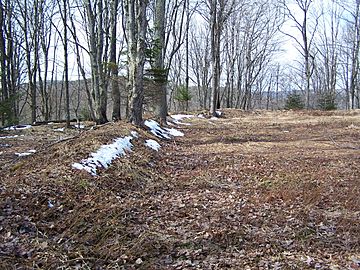White Top facts for kids
Quick facts for kids White Top |
|
|---|---|

Earthworks at Cheat Summit Fort (Fort Milroy)
|
|
| Highest point | |
| Elevation | 4,085 ft (1,245 m) |
| Parent peak | Cheat Mountain |
| Geography | |
| Location | Randolph County, West Virginia |
| Parent range | Allegheny Mountains |
|
Cheat Summit Fort
|
|
| Lua error in Module:Location_map at line 420: attempt to index field 'wikibase' (a nil value). | |
| Location | County Route 250/4, west of FR 233 at White Top, near Huttonsville, West Virginia |
| Area | 34 acres (14 ha) |
| Built | 1861 |
| NRHP reference No. | 90001445 |
| Added to NRHP | September 28, 1990 |
White Top is a part of Cheat Mountain in southeastern Randolph County, West Virginia, USA. It is a high point, or "knob," that reaches about 4,085 feet (1,245 meters) above sea level. You can find it just west of the Shavers Fork of Cheat River and Cheat Bridge. Long ago, a main road called the Staunton-Parkersburg Turnpike crossed White Top. Today, U.S. Route 250 goes around the base of this knob, following the Shavers Fork to the north and east.
Contents
Cheat Summit Fort: A Civil War Story
White Top is famous for being the location of the highest camp for the Union Army during the American Civil War. This camp was called Fort Milroy, or sometimes Cheat Summit Fort. From this high spot, soldiers had an excellent view of the surrounding area. They could easily see the Staunton-Parkersburg Turnpike, which was about 100 feet (30 meters) below the fort. By guarding this road, Fort Milroy helped protect the way into the Tygart Valley River valley to the west.
Building and Life at Fort Milroy
Construction on Fort Milroy began on July 16, 1861. It was named after Union General Robert H. Milroy. Life at such a high elevation was very tough, especially in winter. Snow was reported as early as August 13 that year! By mid-September, the cold was so extreme that horses suffered greatly and did not survive.
Because of these harsh conditions and success in pushing Confederate forces away, the Union Army left the fort in April 1862. One soldier from Indiana wrote about leaving: "With what a light step all started. Soon on the road turning at the brow of the hill, the fourteenth took what I fondly hope is their last look at Cheat Mountain."
The Cheat Summit Fort site was recognized for its history and added to the National Register of Historic Places in 1990.
Fort Milroy Cemetery: A Place of Remembrance
A cemetery was created just south of Fort Milroy for soldiers who passed away there. After the Civil War ended, all the bodies were moved from this site. Many were reburied at the West Virginia National Cemetery in Grafton. Even today, you can still see the dips in the ground where the graves once were.
Discovering the Cheat Mountain Salamander
White Top is also important because it's where the Cheat Mountain salamander was first found. This small animal, a type of vertebrate, was identified in 1935 by scientists M. Graham Netting and Leonard Llewellyn. This special salamander is only found on Cheat Mountain and other nearby mountains in the highlands of West Virginia.

